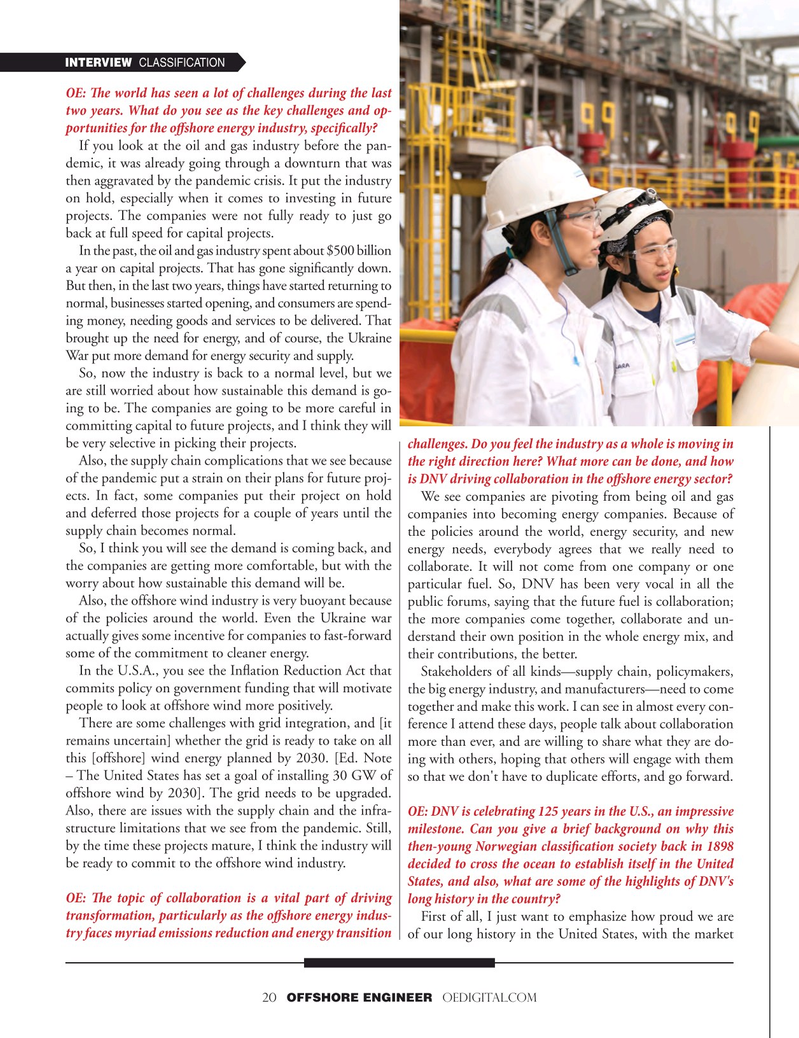
Page 20: of Offshore Engineer Magazine (Mar/Apr 2023)
Read this page in Pdf, Flash or Html5 edition of Mar/Apr 2023 Offshore Engineer Magazine
INTERVIEW CLASSIFICATION
OE: Te world has seen a lot of challenges during the last two years. What do you see as the key challenges and op- portunities for the ofshore energy industry, specifcally?
If you look at the oil and gas industry before the pan- demic, it was already going through a downturn that was then aggravated by the pandemic crisis. It put the industry on hold, especially when it comes to investing in future projects. The companies were not fully ready to just go back at full speed for capital projects.
In the past, the oil and gas industry spent about $500 billion a year on capital projects. That has gone signifcantly down.
But then, in the last two years, things have started returning to normal, businesses started opening, and consumers are spend- ing money, needing goods and services to be delivered. That brought up the need for energy, and of course, the Ukraine
War put more demand for energy security and supply.
So, now the industry is back to a normal level, but we are still worried about how sustainable this demand is go- ing to be. The companies are going to be more careful in committing capital to future projects, and I think they will be very selective in picking their projects. challenges. Do you feel the industry as a whole is moving in
Also, the supply chain complications that we see because the right direction here? What more can be done, and how of the pandemic put a strain on their plans for future proj- is DNV driving collaboration in the ofshore energy sector?
ects. In fact, some companies put their project on hold We see companies are pivoting from being oil and gas and deferred those projects for a couple of years until the companies into becoming energy companies. Because of supply chain becomes normal. the policies around the world, energy security, and new
So, I think you will see the demand is coming back, and energy needs, everybody agrees that we really need to the companies are getting more comfortable, but with the collaborate. It will not come from one company or one worry about how sustainable this demand will be. particular fuel. So, DNV has been very vocal in all the
Also, the offshore wind industry is very buoyant because public forums, saying that the future fuel is collaboration; of the policies around the world. Even the Ukraine war the more companies come together, collaborate and un- actually gives some incentive for companies to fast-forward derstand their own position in the whole energy mix, and some of the commitment to cleaner energy. their contributions, the better.
In the U.S.A., you see the Infation Reduction Act that Stakeholders of all kinds—supply chain, policymakers, commits policy on government funding that will motivate the big energy industry, and manufacturers—need to come people to look at offshore wind more positively. together and make this work. I can see in almost every con-
There are some challenges with grid integration, and [it ference I attend these days, people talk about collaboration remains uncertain] whether the grid is ready to take on all more than ever, and are willing to share what they are do- this [offshore] wind energy planned by 2030. [Ed. Note ing with others, hoping that others will engage with them – The United States has set a goal of installing 30 GW of so that we don't have to duplicate efforts, and go forward.
offshore wind by 2030]. The grid needs to be upgraded.
Also, there are issues with the supply chain and the infra- OE: DNV is celebrating 125 years in the U.S., an impressive structure limitations that we see from the pandemic. Still, milestone. Can you give a brief background on why this by the time these projects mature, I think the industry will then-young Norwegian classifcation society back in 1898 be ready to commit to the offshore wind industry. decided to cross the ocean to establish itself in the United
States, and also, what are some of the highlights of DNV's
OE: Te topic of collaboration is a vital part of driving long history in the country?
transformation, particularly as the ofshore energy indus- First of all, I just want to emphasize how proud we are try faces myriad emissions reduction and energy transition of our long history in the United States, with the market 20 OFFSHORE ENGINEER OEDIGITAL.COM

 19
19

 21
21